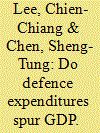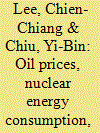|
|
|
Sort Order |
|
|
|
Items / Page
|
|
|
|
|
|
|
| Srl | Item |
| 1 |
ID:
076957


|
|
|
|
|
| Publication |
2007.
|
| Summary/Abstract |
This paper empirically re-examines the long-run co-movements and the causal relationships between GDP and defence expenditures in a multivariate model with real defence expenditure per capita (ME), real GDP per capita (GDP), and real capital stock per capita (K). We apply the view of the aggregate production function to construct the empirical model. Using up-to-date data for 27 OECD countries and 62 non-OECD countries for the 1988-2003 period, we combine cross-sectional and time series data to re-investigate the relationship between GDP and ME. Previous studies using time series data may have yielded misleading results on account of the short time span of typical datasets. By contrast, we use recently developed panel unit root tests and heterogeneous panel cointegration tests, and conclude that there is fairly strong evidence in favour of the hypothesis of a long-run equilibrium relationship between GDP and ME. The long-run panel regression parameter results, such as the fully modified OLS, indicate that a positive relationship between GDP and ME only holds for OECD countries, whereas a negative relationship from ME to GDP only exists in non-OECD countries under examination and in the panel as a whole. Furthermore, by implementing the dynamic panel-based error correction model, we determine that GDP and ME lack short-run causalities, but do show long-run bidirectional causalities in both OECD and non-OECD countries
|
|
|
|
|
|
|
|
|
|
|
|
|
|
|
|
| 2 |
ID:
129494


|
|
|
|
|
| Publication |
2014.
|
| Summary/Abstract |
This study revisits the causal linkages between military spending and economic growth in China and G7 countries (i.e. Canada, France, Germany, Italy, Japan, the UK, and the USA) by focusing country-specific analysis for the period 1988-2010. The panel causality analysis, which accounts for both cross-country dependency and heterogeneity across countries, is employed in this study. Our results find evidence of the neutrality hypothesis for Italy, France, and Germany, the military spending-growth detriment hypothesis for both Canada and the UK, and one-way Granger causality running from economic growth to military spending for China. Furthermore, we find a feedback between military spending and economic growth in both Japan and the USA. Thus, our results do not support that one size fits all.
|
|
|
|
|
|
|
|
|
|
|
|
|
|
|
|
| 3 |
ID:
093466


|
|
|
|
|
| Publication |
2010.
|
| Summary/Abstract |
This study revisits the environmental Kuznets curve (EKC) hypothesis for water pollution by using a recent dynamic technique, which is the generalized method of moments (GMM) approach, for a board sample of 97 countries during the period 1980-2001. On a global scale, as we cannot obtain the EKC relationship between real income and biological oxygen demand (BOD) emissions, this paper further classifies these countries into four regional groups - Africa, Asia and Oceania, America, and Europe - to explore whether the different regions have different ECK relationships. The empirical results show evidence of the inverted U-shaped EKC relationships' existence in America and Europe, but not in Africa and Asia and Oceania. Thus, the regional difference of EKC for water pollution is supported. Furthermore, the estimated turning points are, approximately, US$13,956 and US$38,221 for America and Europe, respectively.
|
|
|
|
|
|
|
|
|
|
|
|
|
|
|
|
| 4 |
ID:
140232


|
|
|
|
|
| Summary/Abstract |
This paper examines how bank capital affects bank profitability and risk in China, and how its impact differed before and after the nation entered the WTO. Our study uses the dynamic generalized method of moments approach with a panel database containing 171 Chinese commercial banks. We find that bank capital has significant influence on bank profitability and risk, but its impact has declined since China joined the WTO in 2001. For different sized groups, the impact of capital on profitability exhibits a distinct trend. The effects of capital on bank risk are different for large and small banks depending on the risk variables used for the Chinese banking industry.
|
|
|
|
|
|
|
|
|
|
|
|
|
|
|
|
| 5 |
ID:
192344


|
|
|
|
|
| Summary/Abstract |
The debate has long prevailed as to whether the financial sectors can enhance energy efficiency. We attempt to provide new insight into this debate from the perspective of commercial bank branch expansion. This paper manually collects the longitude and latitude of commercial bank branches and manufacturing firms in China, and constructs multiple bank branch expansion variables at the firm level. Then, by utilizing Environmental Survey and Reporting database, Annual Survey of Industrial Firms, and firm-level patent application dataset from 1998 to 2009, this paper empirically examines the impact of commercial bank branch expansion on firms' energy efficiency for the first time and discusses the potential impact channels. We find that the expansion of commercial bank branches within a radius of 10 km of firms has improved the manufacturing firms' energy efficiency. Furthermore, we also confirm that there exist multiple heterogeneous nexuses between the bank branch expansion and energy efficiency. Finally, the financial availability caused by the bank branch expansion is not able to affect the energy efficiency, whereas the bank competition will increase the energy efficiency. Also, the bank branch expansion increases energy efficiency by promoting capital renewal instead of technological innovation.
|
|
|
|
|
|
|
|
|
|
|
|
|
|
|
|
| 6 |
ID:
074970


|
|
|
|
|
| Publication |
2006.
|
| Summary/Abstract |
Using the Solow-Swan growth model and the time?trend included in the aggregate production function, this study applies the multivariate cointegration approach to re?investigate the long?run and causal relationships between defence expenditures and GDP while controlling for capital and labour input in Taiwan during the 1955-2002 period. It examines the long?run causal relationship using the weak exogeneity test and utilizes general impulse response functions to determine whether a shock to defence expenditures affects economic growth or vice versa. Our findings provide substantive evidence in favour of the existence of a long?run equilibrium cointegrated relationship between defence expenditures, GDP, labour and capital stock. The results of the weak exogeneity test indicate that a bi?directional causal relationship exists in the long?run between defence expenditures and GDP. Thus, the main policy implication that emerges from the long?run results is that increasing defence expenditures in Taiwan is an effective means to boost overall economic performance and, with this improved economy, it should then be able to increase its defence expenditures further. Lastly, from our dynamic vector error correction model estimations, it is found that defence expenditures are a major means of adjusting for disequilibria that occur within the system.
|
|
|
|
|
|
|
|
|
|
|
|
|
|
|
|
| 7 |
ID:
103343


|
|
|
|
|
| Publication |
2011.
|
| Summary/Abstract |
This paper applies panel data analysis to examine the short-run dynamics and long-run equilibrium relationships among nuclear energy consumption, oil prices, oil consumption, and economic growth for developed countries covering the period 1971-2006. The panel cointegration results show that in the long run, oil prices have a positive impact on nuclear energy consumption, suggesting the existence of the substitution relationship between nuclear energy and oil. The long-run elasticity of nuclear energy with respect to real income is approximately 0.89, and real income has a greater impact on nuclear energy than do oil prices in the long run. Furthermore, the panel causality results find evidence of unidirectional causality running from oil prices and economic growth to nuclear energy consumption in the long run, while there is no causality between nuclear energy consumption and economic growth in the short run.
|
|
|
|
|
|
|
|
|
|
|
|
|
|
|
|
| 8 |
ID:
137934


|
|
|
|
|
| Summary/Abstract |
This study revisits the long run and dynamic causal linkages between defense spending and economic growth in 15 selected European countries for the period 1988–2010 by utilizing recent developments in non-stationary panel data analysis. To this end, the series properties of per capita defense spending, per capita real capital stocks, and per capita real GDP are investigated by the panel unit root tests with and without breaks that support evidence on unit root. The panel cointegration tests with and without breaks are also subsequently employed to investigate whether there exists a long-run equilibrium relationship between these three variables. Finally, our causality analysis from panel vector error-correction model suggests that there is a feedback relation between real capital stock and real GDP in both short and long run, a one-way Granger causality running from real GDP to defense spending in both short and long run, and defense spending only Granger causes real capital stock in the long run.
|
|
|
|
|
|
|
|
|
|
|
|
|
|
|
|
|
|
|
|
|